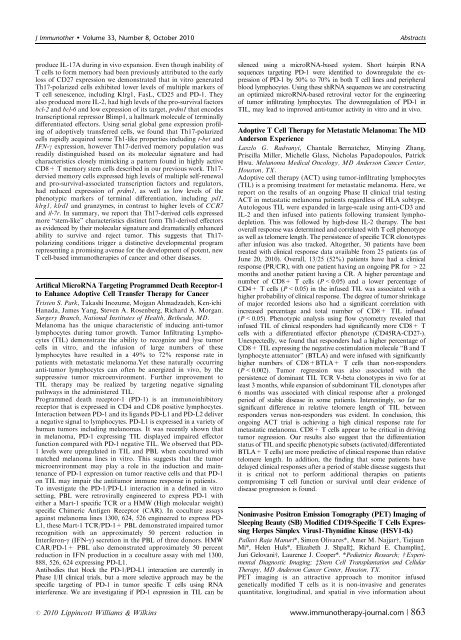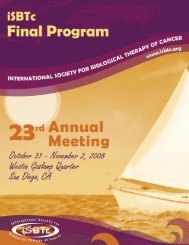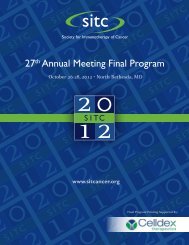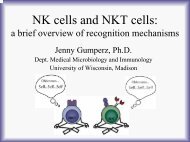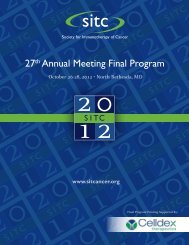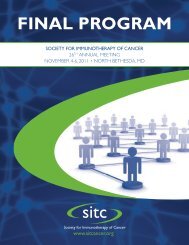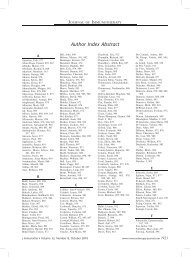Abstracts for the 25th Annual Scientific Meeting of the International ...
Abstracts for the 25th Annual Scientific Meeting of the International ...
Abstracts for the 25th Annual Scientific Meeting of the International ...
Create successful ePaper yourself
Turn your PDF publications into a flip-book with our unique Google optimized e-Paper software.
J Immuno<strong>the</strong>r Volume 33, Number 8, October 2010<br />
<strong>Abstracts</strong><br />
produce IL-17A during in vivo expansion. Even though inability <strong>of</strong><br />
T cells to <strong>for</strong>m memory had been previously attributed to <strong>the</strong> early<br />
loss <strong>of</strong> CD27 expression we demonstrated that in vitro generated<br />
Th17-polarized cells exhibited lower levels <strong>of</strong> multiple markers <strong>of</strong><br />
T cell senescence, including Klrg1, FasL, CD25 and PD-1. They<br />
also produced more IL-2, had high levels <strong>of</strong> <strong>the</strong> pro-survival factors<br />
bcl-2 and bcl-6 and low expression <strong>of</strong> its target, prdm1 that encodes<br />
transcriptional repressor Blimp1, a hallmark molecule <strong>of</strong> terminally<br />
differentiated effectors. Using serial global gene expression pr<strong>of</strong>iling<br />
<strong>of</strong> adoptively transferred cells, we found that Th17-polarized<br />
cells rapidly acquired some Th1-like properties including t-bet and<br />
IFN-g expression, however Th17-derived memory population was<br />
readily distinguished based on its molecular signature and had<br />
characteristics closely mimicking a pattern found in highly active<br />
CD8+ T memory stem cells described in our previous work. Th17-<br />
dervied memory cells expressed high levels <strong>of</strong> multiple self-renewal<br />
and pro-survival-associated transcription factors and regulators,<br />
had reduced expression <strong>of</strong> prdm1, as well as low levels <strong>of</strong> <strong>the</strong><br />
phenotypic markers <strong>of</strong> terminal differentiation, including pd1,<br />
klrg1, klrd1 and granzymes, in contrast to higher levels <strong>of</strong> CCR7<br />
and il-7r. In summary, we report that Th17-derived cells expressed<br />
more ‘‘stem-like’’ characteristics distinct <strong>for</strong>m Th1-derived effectors<br />
as evidenced by <strong>the</strong>ir molecular signature and dramatically enhanced<br />
ability to survive and reject tumor. This suggests that Th17-<br />
polarizing conditions trigger a distinctive developmental program<br />
representing a promising avenue <strong>for</strong> <strong>the</strong> development <strong>of</strong> potent, new<br />
T cell-based immuno<strong>the</strong>rapies <strong>of</strong> cancer and o<strong>the</strong>r diseases.<br />
Artifical MicroRNA Targeting Programmed Death Receptor-1<br />
to Enhance Adoptive Cell Transfer Therapy <strong>for</strong> Cancer<br />
Tristen S. Park, Takashi Inozume, Mojgan Ahmadzadeh, Ken-ichi<br />
Hanada, James Yang, Steven A. Rosenberg, Richard A. Morgan.<br />
Surgery Branch, National Institutes <strong>of</strong> Health, Be<strong>the</strong>sda, MD.<br />
Melanoma has <strong>the</strong> unique characteristic <strong>of</strong> inducing anti-tumor<br />
lymphocytes during tumor growth. Tumor Infiltrating Lymphocytes<br />
(TIL) demonstrate <strong>the</strong> ability to recognize and lyse tumor<br />
cells in vitro, and <strong>the</strong> infusion <strong>of</strong> large numbers <strong>of</strong> <strong>the</strong>se<br />
lymphocytes have resulted in a 49% to 72% response rate in<br />
patients with metastatic melanoma.Yet <strong>the</strong>se naturally occurring<br />
anti-tumor lymphocytes can <strong>of</strong>ten be anergized in vivo, by <strong>the</strong><br />
suppressive tumor microenvironment. Fur<strong>the</strong>r improvement to<br />
TIL <strong>the</strong>rapy may be realized by targeting negative signaling<br />
pathways in <strong>the</strong> administered TIL.<br />
Programmed death receptor-1 (PD-1) is an immunoinhibitory<br />
receptor that is expressed in CD4 and CD8 positive lymphocytes.<br />
Interaction between PD-1 and its ligands PD-L1 and PD-L2 deliver<br />
a negative signal to lymphocytes. PD-L1 is expressed in a variety <strong>of</strong><br />
human tumors including melanomas. It was recently shown that<br />
in melanoma, PD-1 expressing TIL displayed impaired effector<br />
function compared with PD-1 negative TIL. We observed that PD-<br />
1 levels were upregulated in TIL and PBL when cocultured with<br />
matched melanoma lines in vitro. This suggests that <strong>the</strong> tumor<br />
microenvironment may play a role in <strong>the</strong> induction and maintenance<br />
<strong>of</strong> PD-1 expression on tumor reactive cells and that PD-1<br />
on TIL may impair <strong>the</strong> antitumor immune response in patients.<br />
To investigate <strong>the</strong> PD-1/PD-L1 interaction in a defined in vitro<br />
setting, PBL were retrovirally engineered to express PD-1 with<br />
ei<strong>the</strong>r a Mart-1 specific TCR or a HMW (High molecular weight)<br />
specific Chimeric Antigen Receptor (CAR). In coculture assays<br />
against melanoma lines 1300, 624, 526 engineered to express PD-<br />
L1, <strong>the</strong>se Mart-1 TCR/PD-1+ PBL demonstrated impaired tumor<br />
recognition with an approximately 50 percent reduction in<br />
Interferon-g (IFN-g) secretion in <strong>the</strong> PBL <strong>of</strong> three donors. HMW<br />
CAR/PD-1+ PBL also demonstrated approximately 50 percent<br />
reduction in IFN production in a coculture assay with mel 1300,<br />
888, 526, 624 expressing PD-L1.<br />
Antibodies that block <strong>the</strong> PD-1/PD-L1 interaction are currently in<br />
Phase I/II clinical trials, but a more selective approach may be <strong>the</strong><br />
specific targeting <strong>of</strong> PD-1 in tumor specific T cells using RNA<br />
interference. We are investigating if PD-1 expression in TIL can be<br />
silenced using a microRNA-based system. Short hairpin RNA<br />
sequences targeting PD-1 were identified to downregulate <strong>the</strong> expression<br />
<strong>of</strong> PD-1 by 50% to 70% in both T cell lines and peripheral<br />
blood lymphocytes. Using <strong>the</strong>se shRNA sequences we are constructing<br />
an optimized microRNA-based retroviral vector <strong>for</strong> <strong>the</strong> engineering<br />
<strong>of</strong> tumor infiltrating lymphocytes. The downregulation <strong>of</strong> PD-1 in<br />
TIL,mayleadtoimprovedanti-tumoractivityinvitroandinvivo.<br />
Adoptive T Cell Therapy <strong>for</strong> Metastatic Melanoma: The MD<br />
Anderson Experience<br />
Laszlo G. Radvanyi, Chantale Bernatchez, Minying Zhang,<br />
Priscilla Miller, Michelle Glass, Nicholas Papadopoulos, Patrick<br />
Hwu. Melanoma Medical Oncology, MD Anderson Cancer Center,<br />
Houston, TX.<br />
Adoptive cell <strong>the</strong>rapy (ACT) using tumor-infiltrating lymphocytes<br />
(TIL) is a promising treatment <strong>for</strong> metastatic melanoma. Here, we<br />
report on <strong>the</strong> results <strong>of</strong> an ongoing Phase II clinical trial testing<br />
ACT in metastatic melanoma patients regardless <strong>of</strong> HLA subtype.<br />
Autologous TIL were expanded in large-scale using anti-CD3 and<br />
IL-2 and <strong>the</strong>n infused into patients following transient lymphodepletion.<br />
This was followed by high-dose IL-2 <strong>the</strong>rapy. The best<br />
overall response was determined and correlated with T cell phenotype<br />
as well as telomere length. The persistence <strong>of</strong> specific TCR clonotypes<br />
after infusion was also tracked. Altoge<strong>the</strong>r, 30 patients have been<br />
treated with clinical response data available from 25 patients (as <strong>of</strong><br />
June 20, 2010). Overall, 13/25 (52%) patients have had a clinical<br />
response (PR/CR), with one patient having an ongoing PR <strong>for</strong> >22<br />
months and ano<strong>the</strong>r patient having a CR. A higher percentage and<br />
number <strong>of</strong> CD8+ T cells (P


